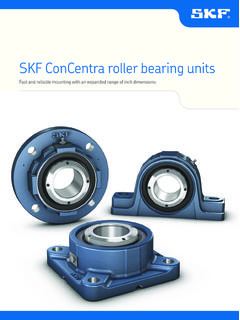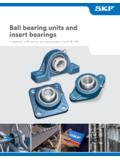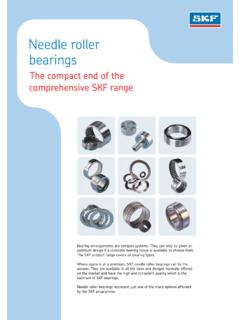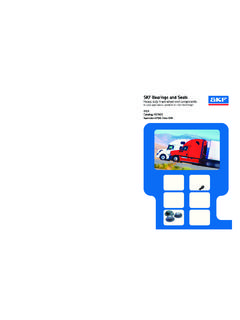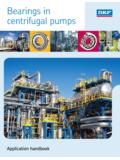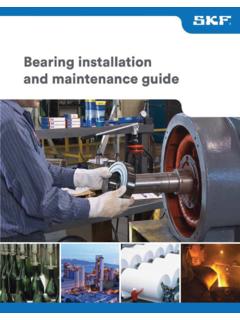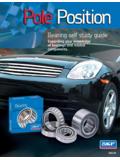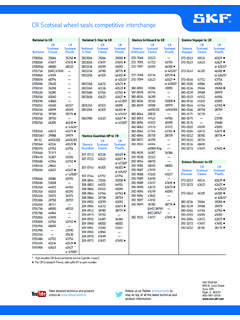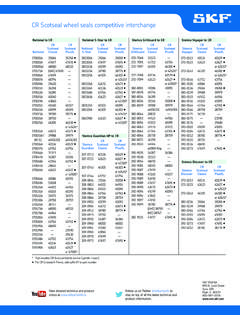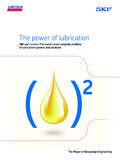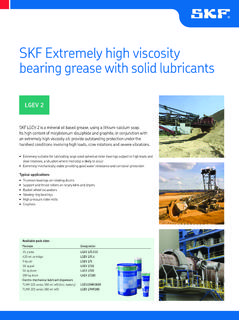Transcription of Bearing investigation - SKF
1 Bearing investigation Extract from the Railway technical handbook, volume 1, chapter 6, page 122 to 135 APX[fPh cTRW]XRP[ WP]SQ^^ZE^[d\T 0g[TQ^gTb fWTT[bTc QTPaX]Vb bT]b^ab R^]SXcX^] \^]Xc^aX]V bdQbhbcT\b P]S bTaeXRTbBearing 6 investigationConsiderations .. 123 Trouble in operation .. 125 Bearing damage .. 126 Damage and failure matrix .. 135122 Bearing investigationRoller bearings are extremely vital components in any railway application. A large number of factors need to be considered to select the appropriate Bearing for an application. But, complete information is not always available. Real operating conditions might differ from the specifications. Wear and tear might change the operating conditions.
2 Also, use of the vehicle might change over time. All of these can influence rolling Bearing service life. Damage to bearings might occur earlier than foreseen. It is therefore important that timely inspections are made to determine the root cause of the problem and that actions are taken necessary to avoid recurrence of the Bearing life is dealt with in the different chapters . However, to select the Bearing final variant, a large number of factors need to be considered . The following main factors influence this selection:type dimensions precision fits clearance cage heat treatment lubrication sealing mounting/dismounting Selecting the appropriate Bearing for the application ( chapter 4 and chapter 5) is only the first step in achieving reliable equipment performance.
3 1236A large number of operating conditions influence the Bearing specificationTypeOperatingconditions mounting/dismounting procedureMountingLubricationCageFitsDime nsions tooling accessibility operating temperature speed shocks vibrations environment seal type relubrication interval operating temperature speed noise vibrations lubricant loads load direction shaft/housing material running precision temperature speed ease of mounting required life loads static load allowed axial load minimum loads temperature viscosity cleanliness housing deformationBearingspecification environment necessity of relubrication frictional moment temperature speed lubricant environment operating temperature dimensional stability preload speed component temperatures fits friction variation speed required precision cost friction availability easy mounting rigidity noise misalignment vibrations shocks speed loads spaceSealingHeat treatmentClearancePrecision124 Trouble in operationIf all the assumptions in the table are met, a Bearing would reach its calculated life.
4 Unfortunately, this is quite hypothetical . There is often something that occurs that prevents ideal operating conditions . Bearings might get damaged and their life impaired .Even the smallest event can have severe consequences an example:A Y25 axlebox can be fitted with two spherical roller bearings . There are two versions, a long axle for 20 tonnes axleload and a shorter axle for 22,5 tonnes axleload . The main difference is the width of the spacer between the bearings . During an overhaul of an axlebox for a 20 tonnes axleload, the wrong distance ring (for 22,5 tonnes axleload) was fitted . The width difference of 21 mm caused the bearings to shift on the journal and, as a result, heat was generated . Shaft fatigue occurred and finally the axle collapsed, leading to a derailment with substantial material damage.
5 A very costly affair indeed compared to the cost of a small spacer .It is clear that identifying the root cause of Bearing damage is the next step in achieving reliable equipment performance . One of the most difficult tasks is identifying the root cause and filtering out any secondary effects that resulted from the root cause of failure .A new Bearing looks beautiful . Its components have been made to exact dimensions, often to fractions of microns . The dimensions have been checked many times during the manufacturing process . The areas that have been ground, such as the surfaces of inner and outer rings and rolling elements, look very shiny .When examining a Bearing that has run for some time, a number of changes can be observed, such as:dull areas on raceways and rolling elements, sometimes even very shinyinner ring and outer ring seats are discolouredcage wear fretting corrosion on the inner ring bore or outer ring outside diameterWhether a Bearing shows minor wear or damage, or has failed completely, a thorough inspection can provide information about what happened to the Bearing during operation.
6 During the inspection, the key is to look for patterns . A pattern can be Y25 axleboxAxlebox after derailment (cut through) Bearing arrangement normal or it can indicate a problem . The patterns found quite frequently identify the root cause of a problem .Calculated life expectancy of any Bearing is based on eight assumptions:The Bearing is the appropriate one for the application .1 The Bearing is of high quality and has no inherent defects .2 Dimensions of parts related to the Bearing , such as shaft and 3 housing seats, are appropriate .The Bearing is mounted correctly .4 The appropriate lubricant in the required quantity is always 5 available to the Bearing .The Bearing arrangement is properly protected (sealed).
7 6 The operating conditions are matched to the Bearing 7 arrangement .Recommended maintenance is performed .8 6125 Bearing damageBecause of the increasing attention given to preventing Bearing damage and failures from recurring, the International Organization for Standardization (ISO) has developed a methodology for classifying Bearing damage and failures (ISO 15243) .This standard recognizes six primary damage/failure modes and their sub-modes related to post-manufacturing sustained damage . These are based primarily upon the features visible on rolling element contact surfaces and other functional surfaces and which identify the mechanisms involved in each type of damage/failure .Most Bearing damage can be linked back to the six main modes as well as their various sub-modes.
8 In the following pages, damage to wheelset bearings are presented . These are the most common damage modes [26] . For additional information, refer to the SKF Maintenance handbook .ISO 15243: Bearing damage classification showing 6 primary failure modes and their and limits of acceptabilityDamage is explained and limits of acceptability are discussed below . Wheelset bearings are very critical components . If any doubt arises on acceptability, the Bearing should be scrapped .However, the limits for acceptability of bearings used in freight wagons are less stringent compared with other applications .For additional information, refer to the chapter Services, section Remanufacturing ( page 192) .Fracture and crackingFalse brinellingFretting corrosionThermal crackingFatigue fractureForced fractureIndentation from handlingIndentation from debrisOverloadCurrent leakageExcessive voltageFrictional corrosionMoisture corrosionAdhesive wearAbrasive wearSurface initiated fatigueSub-surface initiated fatiguePlastic deformationElectrical erosionCorrosionWearFatigue126 FatigueFatigue is a change in the material structure that is caused by the repeated stresses developed in the contacts between the rolling elements and the raceways.
9 Fatigue is mostly manifested visibly as spalling/flaking, i .e . breaking out of material .Sub-surface initiated fatigueDue to repeated stresses, material fatigue results . Structural changes occur underneath the raceway surface and micro cracks develop . When these cracks reach the surface, material breaks loose and spalls occur .Pure sub-surface fatigue under normal operating conditions does not occur frequently, only after very long running time .However, if operating conditions become abnormal, certain areas of the Bearing might become too heavily loaded, leading to early fatigue . One common example is shaft and housing seats that are deformed, i .e . tapered, out-of-round, out-of-square, or thermally distorted.
10 Another possibility is steel that is not clean . Impurities such as oxides weaken the material structure, leading to earlier material fatigue .Limits of acceptability1)Bearings with sub-surface initiated fatigue should always be scrapped .Possible actionCheck bearings seats for conformity .Check loading conditions .Sub-surface initiated fatigue in the outer ring load zoneSurface initiated fatigue in the outer ring of a spherical roller is surface distress on part of the outer ring raceway. In one place spalling has already initiated fatigueSurface initiated fatigue in general is caused by inadequate lubrication . If the lubricant supply or lubricant selection is wrong, or if the lubricant is contaminated, the contact surfaces will no longer be separated by an appropriate lubricant film.
